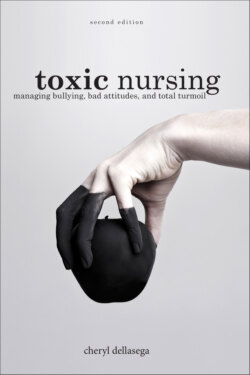Читать книгу Toxic Nursing, 2nd Ed - Cheryl Dellasega - Страница 39
На сайте Литреса книга снята с продажи.
3 | the know-it-all/criticism queen
ОглавлениеWe may not think of nit-picking, fault-finding, and criticism as forms of bullying, but when it happens chronically, it certainly is. According to the Workplace Bullying Institute (WBI), workplace bullying is “repeated, health-harming, mistreatment of one or more persons (the targets) by one or more perpetrators” (WBI, n.d., para. 1). In addition, the Workplace Bullying Institute states that bullying is abusive conduct from one or more perpetrators that can take one or more of the following forms (WBI, n.d.):
• Verbal abuse
• Offensive conduct/behaviors (including nonverbal), which are threatening, humiliating or intimidating
• Work interference—sabotage—which prevents work from getting done
Nurse researchers Anusiewicz, Shirey, and Patrician (2019) used a Rogerian concept analysis to define bullying in relation to new graduate nurses. They describe these three attributes (p. 250): “negative behaviors directed toward an individual who perceives themselves to be a target, a time frame of experiencing these negative behaviors (e.g., daily or weekly) for a prolonged period (e.g., several weeks), and the inclusion of a power gradient or hierarchy between the bully and target.”
This group believes that poor leadership and management are a leading cause of workplace bullying, which results in adverse outcomes on the micro and macro level of healthcare organizations.
How “bullying” is defined often leads to inconsistencies in reporting. For example, what one considers “verbal abuse” can vary from nurse to nurse. Loudly shushing another person can be perceived to be as abusive as shouting at someone they are incompetent.
In a meta-analysis of 45 published papers, Lever and colleagues (2019) found a wide variation in the percent of nurses who reported being “bullied” at work (3.9% to 86.5%). There was consistency in the consequences, however, with both physical and mental health problems resulting from peer aggression in the workplace.
There’s an archetype of women in the workplace: the Queen Bee. There is a “boss lady” (think Miranda Priestly in The Devil Wears Prada) who claws her way to the top and does everything she can to undermine, put down, and generally squash other women who are trying to achieve the same level of success. Interestingly, Zalis (2019) suggests the opposite is true, reporting on research that shows women are now forming their own “clubs” within the workplace. She believes that women who support other women are more successful, a difference that is not true for men.
And yet, somehow this claim doesn’t seem to ring true for nurses. We still seem to have “super nurses,” and these super nurses still seem to have hurtful ego trips at the expense of more junior colleagues. (Of course, not all super nurses are women; plenty of men fit this mold, too.) Perhaps this is one lesson that we can learn from our non-nursing colleagues: We should cherish, mentor, and cultivate our junior colleagues, not rip them to shreds. After all, unless we want to work until the day we die, we’ll need someone to fill our roles when we retire!
Sometimes, the harsh criticism we may give and receive can contain a grain of truth, leading the target to believe that the entire criticism has validity—or worse. Think of nurses who are told they need to “up their game” and advance their professional development. Instead of seeing the part of this feedback that may be well-intended and even complimentary, those who lack confidence and self-esteem may quit, believing they don’t have what it takes to be a good nurse.
More often, instead of being based on a kernel of truth, critical feedback is based on a distortion, fabrication, or misrepresentation. When this happens, victims have a choice: they can speak up or stay silent. If they speak up to defend themselves, they risk further mistreatment by the aggressor. If they stay silent, this seems to implicitly sanction the bullying behavior, and it may slowly build resentment, frustration, and anger. It may also cause some social anxiety in victims, who begin to dread social situations and experience anxiety because they fear being verbally trashed. This, in turn, can negatively affect job performance. After all, how can people be doing their best when they’re constantly looking over their shoulder, trying to anticipate the next obscure, unnecessary criticism?
Commentator Peggy Ann Berry notes,
Bullying behavior, incivility, and disrespectful behaviors are endemic in the stressed environment of nursing. Leadership education on disruptive acts can help nursing staff understand the multiple root causes of bullying behavior and how to decrease the bullying behaviors through their own behavior or response.
Sometimes, however, leadership education alone is not enough. Sometimes, the best approach is to point out the emotional and economic consequences of an aggressor’s overly critical interactions. If bullies understand that there is a zero-tolerance policy—and, the key, that the policy will actually be enforced—their behavior is much more likely to change.
There are no guarantees, though. Often, bullies have been bullies for much of their life, and changing life-long habits can be difficult if not impossible. However, for the sake of new nurses—the future leaders—we must do our very best to ensure that they are not chronically cowed by the know-it-all super nurse.
